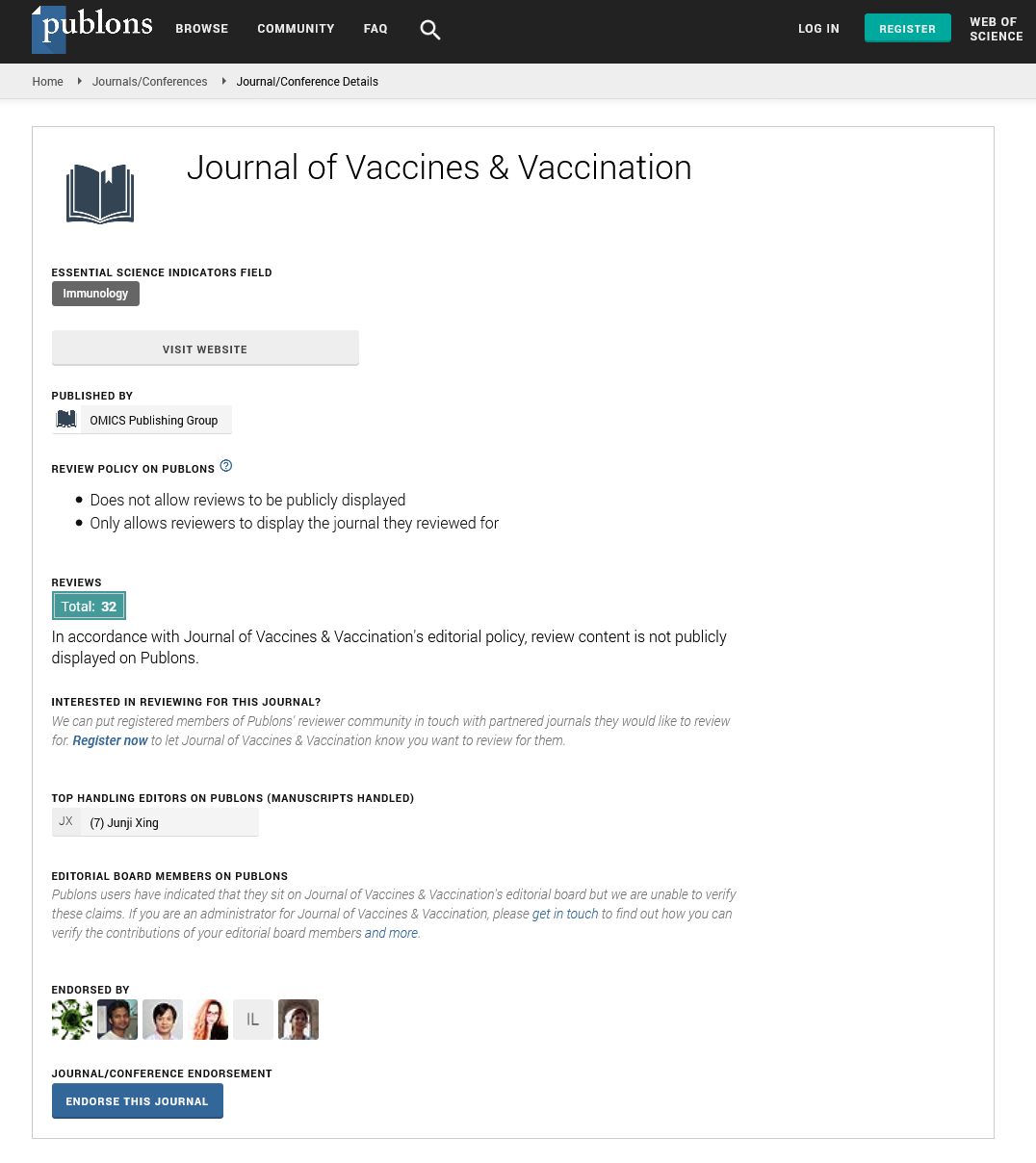Indexed In
- Academic Journals Database
- Open J Gate
- Genamics JournalSeek
- JournalTOCs
- China National Knowledge Infrastructure (CNKI)
- Scimago
- Ulrich's Periodicals Directory
- RefSeek
- Hamdard University
- EBSCO A-Z
- OCLC- WorldCat
- Publons
- MIAR
- University Grants Commission
- Geneva Foundation for Medical Education and Research
- Euro Pub
- Google Scholar
Useful Links
Share This Page
Open Access Journals
- Agri and Aquaculture
- Biochemistry
- Bioinformatics & Systems Biology
- Business & Management
- Chemistry
- Clinical Sciences
- Engineering
- Food & Nutrition
- General Science
- Genetics & Molecular Biology
- Immunology & Microbiology
- Medical Sciences
- Neuroscience & Psychology
- Nursing & Health Care
- Pharmaceutical Sciences
Opinion Article - (2024) Volume 0, Issue 0
Timely Diagnosis of Epiglottitis in Vaccinated Children: A Critical Clinical Focus
Andrew Parkins*Received: 01-Mar-2024, Manuscript No. JVV-24-25715; Editor assigned: 04-Mar-2024, Pre QC No. JVV-24-25715 (PQ); Reviewed: 18-Mar-2024, QC No. JVV-24-25715; Revised: 24-Mar-2024, Manuscript No. JVV-24-25715 (R); Published: 01-Apr-2024, DOI: 10.35248/2157-7560.24.S26.005
About the Study
Epiglottitis is a potentially life-threatening condition that can cause rapid swelling and obstruction of the airway, leading to severe respiratory distress. While the introduction of the Haemophilus influenzae type b (Hib) vaccine has significantly reduced the incidence of epiglottitis in children, it is still a critical diagnosis that must be considered, even in vaccinated individuals. This commentary explores the importance of recognizing epiglottitis in a vaccinated child and the steps necessary to ensure a timely and lifesaving diagnosis.
Epiglottitis primarily affects the epiglottis, a flap of tissue located at the base of the tongue that prevents food and liquids from entering the windpipe during swallowing. Inflammation and swelling of the epiglottis can rapidly lead to airway obstruction, making it a medical emergency. Before the widespread use of the Hib vaccine, Haemophilus influenzae type b was the most common cause of epiglottitis in children. Since the introduction of the vaccine, the incidence of epiglottitis caused by Hib has dramatically decreased. However, other bacteria such as Streptococcus pneumoniae and Staphylococcus aureus, as well as viral and fungal infections, can still cause the condition.
The clinical presentation of epiglottitis in children can be sudden and severe. Symptoms often include high fever, sore throat, difficulty swallowing, drooling, and a characteristic "tripod" posture where the child leans forward with an open mouth and protruding tongue to maximize airflow. Stridor, a high-pitched wheezing sound, may also be present, indicating partial airway obstruction. Due to the rapid progression of the disease, early recognition and intervention are essential.
In a vaccinated child, the initial suspicion of epiglottitis may be lower due to the protective effects of the Hib vaccine. However, it is essential for healthcare providers to remain vigilant and consider epiglottitis in the differential diagnosis when a child presents with acute respiratory distress and the aforementioned symptoms. Delays in diagnosis and treatment can result in severe complications, including complete airway obstruction and respiratory failure.
The diagnosis of epiglottitis is primarily clinical, but it can be confirmed through imaging and direct visualization. Lateral neck radiographs may show the "thumbprint sign," indicative of a swollen epiglottis. However, direct visualization using laryngoscopy, typically performed in a controlled environment such as an operating room, provides definitive confirmation. It is important to note that any attempt to visualize the epiglottis in an unstable child should be performed with caution to avoid exacerbating the airway obstruction.
Once epiglottitis is suspected or diagnosed, securing the airway is the immediate priority. This often requires the expertise of anesthesiologists and otolaryngologists. Endotracheal intubation or, in severe cases, a tracheotomy may be necessary to maintain an open airway. Following airway stabilization, appropriate antibiotic therapy should be initiated to treat the underlying infection. Empiric antibiotic coverage typically includes agents effective against common causative organisms, such as third generation cephalosporins.
The importance of vaccination in preventing epiglottitis cannot be overstated. The Hib vaccine has been highly effective in reducing the incidence of this condition. However, no vaccine is 100% effective, and breakthrough cases can occur. Additionally, other pathogens can cause epiglottitis, underscoring the need for continued vigilance and adherence to vaccination schedules.
Preventative measures extend beyond the Hib vaccine. Ensuring that children receive all recommended vaccinations, including those against Streptococcus pneumoniae and influenza, can further reduce the risk of epiglottitis and other severe infections. Education of parents and caregivers about the signs and symptoms of epiglottitis is also vital, enabling them to seek immediate medical attention if they suspect their child is affected.
Conclusion
In conclusion, while vaccination has significantly decreased the incidence of epiglottitis, healthcare providers must remain aware of this potentially life-threatening condition even in vaccinated children. Early recognition, timely diagnosis, and prompt intervention are essential to prevent severe complications and ensure positive outcomes. Through continued vigilance, adherence to vaccination schedules, and education, we can minimize the risks associated with epiglottitis and safeguard the health and well-being of children.
Citation: Parkins A (2024) Timely Diagnosis of Epiglottitis in Vaccinated Children: A Critical Clinical Focus. J Vaccines Vaccin. S26:005.
Copyright: © 2024 Parkins A. This is an open-access article distributed under the terms of the Creative Commons Attribution License, which permits unrestricted use, distribution, and reproduction in any medium, provided the original author and source are credited.

